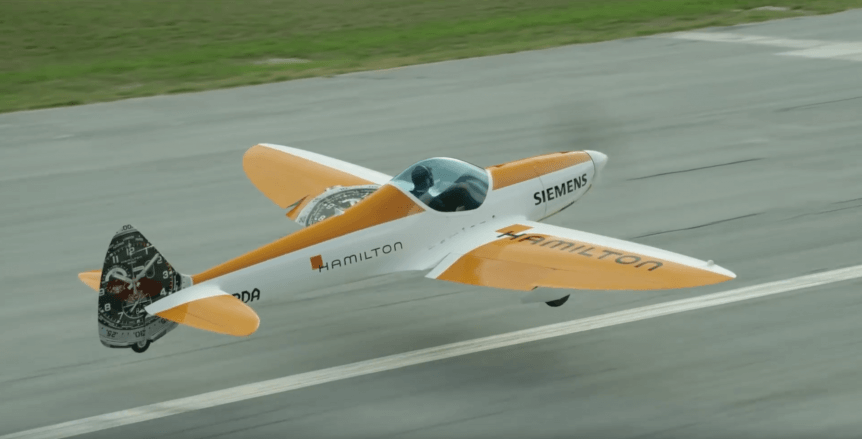Electric airplanes currently can give 15 or 20 minutes of intense aerobatics, or about an hour of more sedate cruising. What if you had a lovely little airplane that invited flinging it about the sky, but you still wanted to visit distant places? In 2005, Mike Friend owned a Silence Twister, a Spitfire-like single-seater registered as N787M, a nod to Mike’s employer, Boeing. He thought about making it a hybrid craft. Waiting for Batteries An early effort around 2010 by a German company to electrify the Twister did not produce a surge of orders, and Mike presented a 2011 symposium feature on making a hybrid out of the Twister to reduce its fuel burn while retaining its frisky character. That approach would have used a pod under the belly of the Twister, making it look like a fighter with an auxiliary fuel tank. Aerobatics combined with long-range seemed like a potential winner. Cute as it was, the concept was still …
Diamond’s Hybrid-Electric Tiltrotor
Diamond Aircraft of Austria gave Flying magazine news of its hybrid-electric tiltrotor project – something not announced on Diamond’s own web site. According to Flying, Diamond will partner with an unnamed “major industrial partner.” The airplane could become certified within seven years, enabling customers to own a six-passenger vertical takeoff and landing vehicle with ostensibly high speed and the ability to set down virtually anywhere. Diamond founder and CEO Christian Dries says the craft will be powered by two high-output Siemens electric motors with power to recharge the batteries in flight supplied by a pair of Austro diesel engines. Since there are four propellers, the motors’ outputs would probably be split fore and aft to a pair of rotors. The unnamed concept would have a maximum takeoff weight of 6,600 pounds. To test the concept, Diamond will build a 725-pound unpiloted prototype starting next month. That will be followed by a 2,800-pound prototype, with the full, fly-by-wire production version coming …
RX1E, Sun Flyer Both Score More than a Score (of Orders)
China Daily reports, “The world’s first electric passenger aircraft to gain an airworthiness certificate has been produced by China.” Whether the “first” certification statement is true will probably become a matter of debate, with Pipistrel’s Alpha Electro being certified in France and seeking more general approvals from other countries including America. Pipistrel has been selling a Taurus Electro G2 self-launching sailplane for the last several years, and makes the following claims for it. “Taurus Electro G2 is the only electric 2-seat aeroplane in serial production available on the market. Furthermore, Pipistrel believes it is the only truly useful electric aircraft out there, because the electric drive is applied to the glider airframe, where battery capacity is not a limiting factor in performance/endurance. Taurus Electro G2 represents a leap forward in performance, safety, functionality and user friendliness.” We noted the RX1E’s certification in the blog a few months ago. It’s in production in China with the first two aircraft delivered to Liaoning …
Powering Imagination at the Museum of Flight
Powering Imagination, a symposium devoted to that premise and to encouraging the development of electric aviation, achieved both goals on Saturday, February 28 at Seattle’s Museum of Flight. Organized by Erik Lindbergh and Eric Bartsch, the gathering included two panel discussions and eight presentations that helped define where the world of electric flight might be heading. Between 10:00 a.m. and 5:00 p.m., presenters covered a lot of ground. Following Cale Wilcox, the Public Programs Coordinator for the Museum’s, introduction, Erik Lindbergh took the stage to explain the goals of the Powering Imagination organization, including making aviation clean, quiet, exciting and affordable. This democratization of flight mirrors aspirations of the CAFE Foundation and is reflected in the educational efforts made by Lindbergh’s organization. He explained that the X-Prize helped jump start private space flight, then asked how we translate that interest into helping form an electric aircraft industry. Development of this new industry may be crucial to aviation’s survival, with its …

